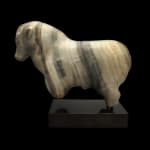Bactrian Bull Figure , 2250 BC - 1700 BC
Chalcedony
15.5 x 7.5 x 23.5 cm
6 1/8 x 3 x 9 1/4 in
6 1/8 x 3 x 9 1/4 in
CC.19
Further images
-
(View a larger image of thumbnail 1
)

-
(View a larger image of thumbnail 2
)

-
(View a larger image of thumbnail 3
)

-
(View a larger image of thumbnail 4
)

-
(View a larger image of thumbnail 5
)

-
(View a larger image of thumbnail 6
)

-
(View a larger image of thumbnail 7
)

-
(View a larger image of thumbnail 8
)

-
(View a larger image of thumbnail 9
)

-
(View a larger image of thumbnail 10
)

This handsomely carved bull exudes musculature and power. It is the product of the Bactria-Margiana Archaeological Complex (BMAC), also known as the Oxus Civilization, which flourished in Central Asia from...
This handsomely carved bull exudes musculature and power. It is the product of the Bactria-Margiana Archaeological Complex (BMAC), also known as the Oxus Civilization, which flourished in Central Asia from 2250 BC to 1700 BC. This brief fluorescence produced a high standard of artistic achievement. This bull is an exceptional example. Produced in chalcedony or agate, unusually hard stones with beautiful striations, this bull has a softness of form that makes this a very tactile piece. Finely carved details are included in the face, ears, tail and underside, which show a developed understanding of the anatomy of these creatures. A diamond shape crowns the bull, above gentle almond-shaped eyes, and a muzzle with flared nostrils. The figure is missing the horns and the lower portion of the legs, but is otherwise extraordinarily well-preserved.
Bulls are well-attested in Bactrian art, with numerous bronze examples on the open market. They are often small, taking the form of cosmetic bottles or amulets; very few exist of this size and prominence, and few are known in stone. Bulls were probably associated with the power and prestige of the ruling class, much like in other ancient societies from Egypt to Mesopotamia. But we must also remember that bulls were important working agricultural animals, and the intimate knowledge of their anatomy shown in this example demonstrates a people closely connected to their agricultural lifestyle.
This is an immediately engaging piece: characterful, tactile and beautiful. The skill of the artist is evident in the tiny details – the fur inside the ear, the gentle curve of the foreleg – which draw the viewer in, as well as the masterful overall composition.
Bulls are well-attested in Bactrian art, with numerous bronze examples on the open market. They are often small, taking the form of cosmetic bottles or amulets; very few exist of this size and prominence, and few are known in stone. Bulls were probably associated with the power and prestige of the ruling class, much like in other ancient societies from Egypt to Mesopotamia. But we must also remember that bulls were important working agricultural animals, and the intimate knowledge of their anatomy shown in this example demonstrates a people closely connected to their agricultural lifestyle.
This is an immediately engaging piece: characterful, tactile and beautiful. The skill of the artist is evident in the tiny details – the fur inside the ear, the gentle curve of the foreleg – which draw the viewer in, as well as the masterful overall composition.









